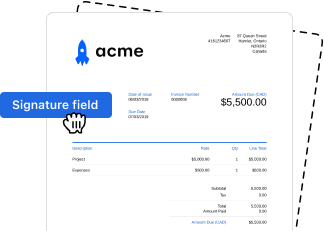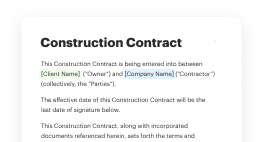Unlock the eSignature Lawfulness for Insurance Industry in Mexico
- Quick to start
- Easy-to-use
- 24/7 support
Simplified document journeys for small teams and individuals




We spread the word about digital transformation
Why choose airSlate SignNow
-
Free 7-day trial. Choose the plan you need and try it risk-free.
-
Honest pricing for full-featured plans. airSlate SignNow offers subscription plans with no overages or hidden fees at renewal.
-
Enterprise-grade security. airSlate SignNow helps you comply with global security standards.







Your complete how-to guide - esignature lawfulness for insurance industry in mexico
eSignature Lawfulness for Insurance Industry in Mexico
In the insurance industry in Mexico, ensuring the lawfulness of eSignatures is paramount. With the use of airSlate SignNow, businesses can streamline their processes while adhering to legal requirements.
Steps to Utilize airSlate SignNow for eSignatures:
- Launch the airSlate SignNow web page in your browser.
- Sign up for a free trial or log in.
- Upload a document you want to sign or send for signing.
- If you're going to reuse your document later, turn it into a template.
- Open your file and make edits: add fillable fields or insert information.
- Sign your document and add signature fields for the recipients.
- Click Continue to set up and send an eSignature invite.
airSlate SignNow offers businesses an easy-to-use, cost-effective solution for sending and eSigning documents. With features tailored for SMBs and Mid-Market, it provides great ROI and transparent pricing without hidden fees. Additionally, the platform offers superior 24/7 support for all paid plans.
Experience the benefits of airSlate SignNow today and elevate your eSignature processes for the insurance industry in Mexico.
How it works
Rate your experience
What is the esignature lawfulness for insurance industry in Mexico
The esignature lawfulness for the insurance industry in Mexico is grounded in the legal framework established by the Federal Civil Code and the Electronic Signature Law. These laws recognize electronic signatures as legally binding, provided they meet certain criteria. This includes the ability to identify the signatory and ensure the integrity of the signed document. For insurance companies, this means that electronic signatures can be used for policy agreements, claims, and other essential documents, streamlining processes while maintaining compliance with legal standards.
How to use the esignature lawfulness for insurance industry in Mexico
To effectively use the esignature lawfulness in the insurance sector, businesses should integrate electronic signature solutions like airSlate SignNow into their workflows. This involves setting up an account, uploading necessary documents, and using the platform to fill out and send documents for signature. Users can add signature fields, request additional information, and track the signing process in real-time, ensuring that all parties are kept informed. This approach not only enhances efficiency but also ensures compliance with legal requirements.
Steps to complete the esignature lawfulness for insurance industry in Mexico
Completing the esignature lawfulness process involves several key steps:
- Prepare the document by uploading it to the eSignature platform.
- Fill out necessary fields, including policy details and signatory information.
- Add signature fields where required, ensuring all parties can sign.
- Send the document for signature, specifying the order of signatories if necessary.
- Monitor the signing process to ensure timely completion.
- Once signed, securely store the completed document for future reference.
Legal use of the esignature lawfulness for insurance industry in Mexico
The legal use of esignatures in the Mexican insurance industry is supported by the Electronic Signature Law, which stipulates that electronic signatures are equivalent to handwritten signatures when certain conditions are met. These conditions include the use of secure signature creation devices and proper identification of the signatory. Insurance companies must ensure that their electronic signature processes comply with these legal requirements to avoid disputes and uphold the validity of signed documents.
Security & Compliance Guidelines
When implementing esignatures in the insurance industry, security and compliance are paramount. Companies should follow these guidelines:
- Use encryption to protect documents during transmission and storage.
- Implement multi-factor authentication to verify the identity of signatories.
- Maintain an audit trail of all signed documents, including timestamps and IP addresses.
- Regularly review and update security protocols to address emerging threats.
- Ensure compliance with applicable laws and regulations, including data protection standards.
Documents You Can Sign
In the insurance industry, various documents can be signed electronically, including:
- Insurance policy agreements
- Claims forms
- Renewal notices
- Disclosure statements
- Endorsements and amendments
Using an electronic signature solution allows for the efficient handling of these documents while ensuring they remain legally binding.
-
Best ROI. Our customers achieve an average 7x ROI within the first six months.
-
Scales with your use cases. From SMBs to mid-market, airSlate SignNow delivers results for businesses of all sizes.
-
Intuitive UI and API. Sign and send documents from your apps in minutes.
FAQs
-
What is the esignature lawfulness for the insurance industry in Mexico?
The esignature lawfulness for the insurance industry in Mexico is governed by the Federal Civil Code and the Electronic Commerce Law. These regulations recognize electronic signatures as legally binding, provided they meet specific security and authentication standards. This ensures that insurance companies can confidently use esignatures for their transactions.
-
How does airSlate SignNow ensure compliance with esignature lawfulness for the insurance industry in Mexico?
airSlate SignNow complies with the esignature lawfulness for the insurance industry in Mexico by implementing advanced security measures and authentication protocols. Our platform adheres to local regulations, ensuring that all electronic signatures are legally valid and enforceable. This compliance helps insurance companies streamline their processes while maintaining legal integrity.
-
What features does airSlate SignNow offer for the insurance industry?
airSlate SignNow offers a range of features tailored for the insurance industry, including customizable templates, bulk sending, and real-time tracking of document status. These features enhance efficiency and ensure that all documents are signed in accordance with esignature lawfulness for the insurance industry in Mexico. Additionally, our user-friendly interface makes it easy for agents and clients to navigate the signing process.
-
Is airSlate SignNow cost-effective for insurance companies?
Yes, airSlate SignNow is a cost-effective solution for insurance companies looking to implement esignature lawfulness for the insurance industry in Mexico. Our pricing plans are designed to accommodate businesses of all sizes, allowing you to choose a plan that fits your budget. By reducing paper usage and streamlining workflows, our platform can lead to signNow cost savings over time.
-
Can airSlate SignNow integrate with other software used in the insurance industry?
Absolutely! airSlate SignNow offers seamless integrations with various software commonly used in the insurance industry, such as CRM systems and document management tools. This compatibility ensures that you can maintain your existing workflows while adhering to esignature lawfulness for the insurance industry in Mexico. Our API also allows for custom integrations tailored to your specific needs.
-
What are the benefits of using airSlate SignNow for insurance documents?
Using airSlate SignNow for insurance documents provides numerous benefits, including faster turnaround times, enhanced security, and improved customer satisfaction. By ensuring compliance with esignature lawfulness for the insurance industry in Mexico, you can confidently manage your documents electronically. This not only saves time but also enhances the overall client experience.
-
How secure is airSlate SignNow for handling sensitive insurance documents?
airSlate SignNow prioritizes security by employing advanced encryption and authentication measures to protect sensitive insurance documents. Our platform is designed to comply with esignature lawfulness for the insurance industry in Mexico, ensuring that all transactions are secure and legally binding. You can trust that your data is safe while using our services.




























